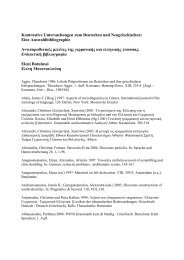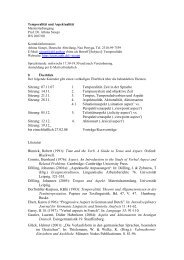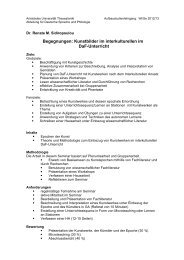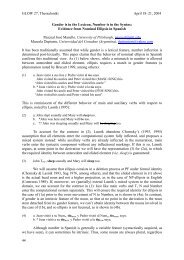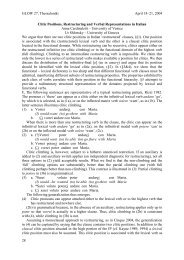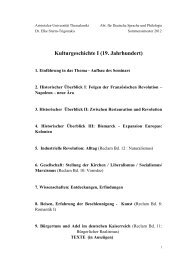Rose-Marie Dechaine and Martina Wiltschko (UBC)
Rose-Marie Dechaine and Martina Wiltschko (UBC)
Rose-Marie Dechaine and Martina Wiltschko (UBC)
Create successful ePaper yourself
Turn your PDF publications into a flip-book with our unique Google optimized e-Paper software.
distribution of N, e.g. the occurrence of English self in compounding. Languages which have noun<br />
incorporation also have incorporated reflexive pro-NPs; this a predictable by-product of their N-syntax.<br />
4. The structural invariance of reciprocals. Heim, Lasnik & May 1991 argue that a reciprocal<br />
construction involves at least 4 parts: a plural antecedent, a distributor, a reciprocator, <strong>and</strong> a predicate, as<br />
in (3).<br />
(3) a. The men saw each other.<br />
b. [ S [ NP [ NP the men i ] each 2 ] [ S e 1 [ VP [ NP e 2=VBL other] 3 [ VP saw e 3 ]]]]<br />
GROUP DISTRIBUTOR RECIPROCATOR PREDICATE<br />
In a similar vein we argue that the syntax of a reciprocal expression (defined as the linguistic element<br />
which marks the reciprocal relation, e.g. each other in English) derives from independently motivated<br />
properties. We claim that there is a transparent relation between the semantics <strong>and</strong> the syntax of<br />
reciprocals, such that the distributor corresponds to a syntactic D-position, the plural variable induced<br />
by the distributive operator corresponds to a syntactic φ-position, <strong>and</strong> the reciprocator (a kind of disjoint<br />
anaphor) corresponds to a syntactic N-position. This is illustrated in (4):<br />
(4) syntax/semantics mapping for reciprocals<br />
distributor D = distributor (derives effect of ∀)<br />
plural variable φ = plural variable (Déchaine & <strong>Wiltschko</strong> 2002)<br />
plurality is forced by distributor which in turn forces plural antecedent via<br />
agreement<br />
local disjointness N = reciprocator (a kind of disjoint anaphor; cf. Saxon 1984, 1986)<br />
Consequently, argument-type reciprocals are invariantly realized as DPs - language internally as well as<br />
cross-linguistically. We analyze apparent surface differences in the overt realization of reciprocal<br />
expressions as reflecting which part of the DP-structure is spelled out. We will show that this proposal<br />
solves some long-st<strong>and</strong>ing problems in the syntax <strong>and</strong> semantics of reciprocals.<br />
4.1. Non-parallelism between reflexives <strong>and</strong> reciprocals. Under our account the distributional<br />
differences between reflexives <strong>and</strong> reciprocals follows from two factors. First, reciprocals are always<br />
DPs whereas reflexives can be DPs, φPs or NPs. In addition, we argue that non-local binding of<br />
reciprocals is possible because there is no other way of expressing the reciprocal relation (i.e. there is no<br />
blocking). Conversely, the occurrence of reflexives in the same context is blocked by the existence of<br />
the more highly specified form his own (Williams 1994).<br />
Moreover, in languages that permit long-distance binding of reflexives, we observe the absence of<br />
long-distance reciprocals. We take this to reflect the fact that reciprocals are always evaluated w.r.t to<br />
the most accessible antecedent. Under the proposed analysis, this follows from the status of the<br />
reciprocator as a disjoint anaphor, which according to Saxon 1984, is always disjoint in reference from<br />
the most locally accessible antecedent.<br />
4.2. Absence of dedicated reciprocals. Our proposal further predicts that there are no dedicated<br />
reciprocals, which we take to be a welcome result, given the goal of the principles <strong>and</strong> parameters<br />
framework to get rid of construction specific notions. We observe that the elements which make up a<br />
reciprocal expression occur in non-reciprocal contexts. The syntactic analysis proposed here predicts<br />
that when the reciprocal construal is not forced, then the overt element(s) of the reciprocal expression<br />
are construed in terms of their inherent semantics. Thus, the distributor/D component is interpreted as a<br />
pure distributive operator in non-reciprocal contexts (e.g. in Madurese). The variable/φ component is<br />
interpreted as a pure variable in non-reciprocal contexts (e.g. Romance se). The reciprocator/N<br />
component is interpreted as a pure disjoint anaphor in non-reciprocal contexts (e.g. Plains Cree).<br />
5. Consequences. In this talk we show that just like Condition B <strong>and</strong> C can be derived, so can<br />
Condition A. Consequently, with this analysis in place we can dispense with binding theory as a separate<br />
module of grammar. This is a welcome result given the general goals of recent theorizing (i.e. the<br />
minimalist program).



